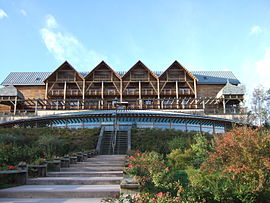Cransac | |
|---|---|
 The thermal baths | |
| Coordinates: 44°31′33″N 2°17′07″E / 44.5258°N 2.2853°E | |
| Country | France |
| Region | Occitania |
| Department | Aveyron |
| Arrondissement | Villefranche-de-Rouergue |
| Canton | Enne et Alzou |
| Government | |
| • Mayor (2023–2026) | Bernard Canac[1] |
| Area 1 | 6.91 km2 (2.67 sq mi) |
| Population (2021)[2] | 1,469 |
| • Density | 210/km2 (550/sq mi) |
| Time zone | UTC+01:00 (CET) |
| • Summer (DST) | UTC+02:00 (CEST) |
| INSEE/Postal code | 12083 /12110 |
| Elevation | 274–470 m (899–1,542 ft) (avg. 277 m or 909 ft) |
| 1 French Land Register data, which excludes lakes, ponds, glaciers > 1 km2 (0.386 sq mi or 247 acres) and river estuaries. | |
Cransac (French pronunciation: [kʁɑ̃sak]) is a commune in the Aveyron department in southern France. Cransac station has rail connections to Brive-la-Gaillarde, Figeac and Rodez.
The town was a coal-mining centre until the mine closed in 1962.[3] Cransac has mineral springs, known in the middle ages. There are iron-mines in the neighbourhood. Hills to the north of the town contain disused coal-mines which have been on fire for centuries. About 8 kilometres (8,000 m) to the south is the fine Renaissance château of Bournazel, built for the most part by Jean de Buisson, baron of Bournazel, about 1545. The barony of Bournazel became a marquisate in 1624.[4]

Population
[edit]| Year | Pop. | ±% |
|---|---|---|
| 1962 | 2,356 | — |
| 1968 | 3,244 | +37.7% |
| 1975 | 2,870 | −11.5% |
| 1982 | 2,520 | −12.2% |
| 1990 | 2,180 | −13.5% |
| 1999 | 1,821 | −16.5% |
| 2008 | 1,681 | −7.7% |
See also
[edit]References
[edit]- ^ "Répertoire national des élus: les maires" (in French). data.gouv.fr, Plateforme ouverte des données publiques françaises. 6 June 2023.
- ^ "Populations légales 2021" (in French). The National Institute of Statistics and Economic Studies. 28 December 2023.
- ^ "The Burning Mountain". Experience (my) France. Retrieved 29 May 2017.
- ^ One or more of the preceding sentences incorporates text from a publication now in the public domain: Chisholm, Hugh, ed. (1911). "Cransac". Encyclopædia Britannica. Vol. 7 (11th ed.). Cambridge University Press. p. 378.




Well, that’s interesting to know that Psilotum nudum are known as whisk ferns. Psilotum nudum is the commoner species of the two. While the P. flaccidum is a rare species and is found in the tropical islands. Both the species are usually epiphytic in habit and grow upon tree ferns. These species may also be terrestrial and grow in humus or in the crevices of the rocks.
View the detailed Guide of Psilotum nudum: Detailed Study Of Psilotum Nudum (Whisk Fern), Classification, Anatomy, Reproduction